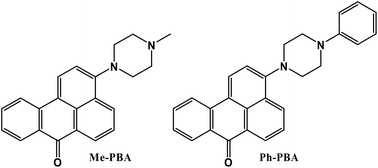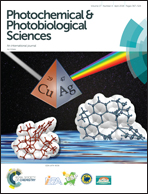Photophysical properties of benzanthrone derivatives: effect of substituent, solvent polarity and hydrogen bonding†
Abstract
Benzanthrone derivatives are potential fluorescent probes for various chemical and biological environments. A mechanistic understanding of their photophysical properties is pivotal for designing an efficient fluorescence sensor based on the benzanthrone framework. In this study, we report on the effect of chemical substitution on the photophysical properties of two benzanthrone derivatives, namely, 3-(N′-methyl)-piperazino-7H-benzo[de]anthracen-7-one [Me-PBA] and 3-(N′-phenyl)-piperazino-7H-benzo[de]anthracen-7-one [Ph-PBA] in different solvents and solvent mixtures of varying polarities and proticities. Both benzanthrone derivatives show interesting solvent-dependent photophysical properties. Although both derivatives exhibit strong intramolecular charge transfer (ICT) characteristics in the excited state, the extent of the charge transfer is significantly influenced by the nature of the chemical substitution. Modulation of photophysical parameters as a function of solvent properties led us to propose that ICT is affected by solvent polarity and hydrogen bonding. From the viscosity effect, it is revealed that the weaker emission of Ph-PBA compared to Me-PBA in polar solvents is primarily due to the non-radiative torsional motion of the phenyl group in the former derivative. In protic solvents, intermolecular hydrogen bonding imparts strong non-radiative deactivation to both derivatives, thus rendering a weak fluorescence yield.



 Please wait while we load your content...
Please wait while we load your content...